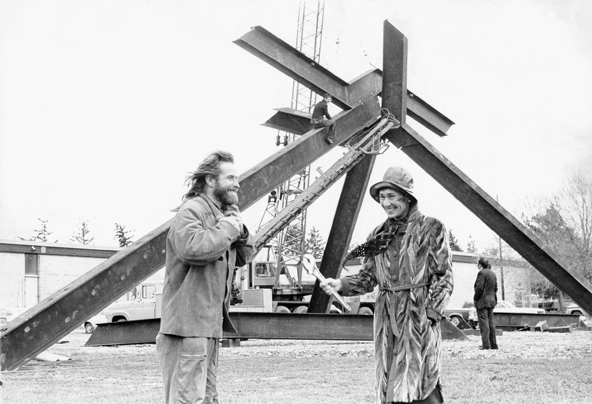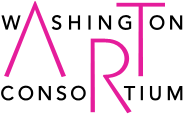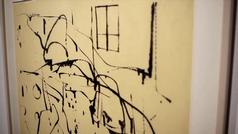Founding the Washington Art Consortium’s Original Collection
By Virginia Wright
Editorial Note: The collection of Works on Paper: American Art 1945-1975 was assembled in 1976, and made possible through funding by the National Endowment of the Arts and the Virginia Wright Fund. The following essay is Virginia Wright’s description of the development of the collection.
The Virginia Wright Fund was established in 1969 by my father, Prentice Bloedel, with a gift of $1,000,000. At the time, I was surprised and touched by my father’s gift because I knew he really wasn’t much interested in contemporary art. It seems he was motivated solely by his desire to support me and my interests, and he chose a particularly prescient way of doing it. In later years, he made additional contributions including a final gift in the spring of 1996, a few months before his death. The date of the Fund’s inception, 1969, made it one of the earliest funding sources for art in public places in the country and the first in the Northwest. The “Art in Public Places” program of the Seattle Art Commission, for instance, did not begin until 1973.

The Virginia Wright Fund’s mission, stated in its bylaws, was simple: “acquire or commission works of art for public spaces.” In its early meetings, the Trustees added other requirements: the acquired works should be permanently located and continuously on view, and if possible, be part of a collection rather than stand alone, as single works. Because it was believed that museums would not readily agree to show any work of art permanently, outdoor sites were chosen and the project invariably large scale sculpture. (Notable examples of commissions, to which the Fund contributed: Barnett Newman’s Broken Obelisk at the University of Washington; Richard Serra’s Wright’s Triangle and Mark diSuvero’s For Handel at Western Washington University; Alexander Liberman’s Olympic Triad at the Seattle Center; Jonathan Borofsky’s Hammering Man at the Seattle Art Museum.) Small pieces of sculpture and two dimensional work, painting and drawings, were considered too fragile for non-museum public spaces. As time went by, though, we realized we should find a way to deal with the work of painters as well as sculptors. If we were to bring the work of important artists like Pollock and de Kooning to the Northwest, we would have to bend our rules about placing works on permanent view. Otherwise, museums could not be eligible for gifts.
“After much deliberation, a novel and ambitious plan was developed. A collection would be formed — a survey of American art of the post-war era, from 1945-1975, but it would not belong to any one museum.”
— Virginia Wright
After much deliberation, a novel and ambitious plan was developed. A collection would be formed — a survey of American art of the post-war era, from 1945-1975, but it would not belong to any one museum. Instead, it could be treated as a road show, touring continuously throughout the state. The works themselves would be drawings and works on paper, easy to transport and easy to handle. The fund would put up $100,000 and we would seek a matching grant from the National Endowment for the Arts.
I went to Washington, D.C. in early summer of 1974 to get a reading from the NEA. I met with Richard Koshalek and David Ryan, both about to begin distinguished careers in American museums. They pointed out that, under their Museum Purchase Plan, grants could not be given to a private foundation like the Virginia Wright Fund and that the maximum grant for any museum was $20,000, a far cry from the $100,000 we were looking for. They were excited about the idea, however, and after some brainstorming, they came up with a solution. If we could persuade five museums to band together, each asking for the $20,000, the maximum grant, their funds could be pooled and matched with a $100,000 grant from our Fund. With $200,000 we could proceed with the collection. Thus the Washington Art Consortium was born – a strategy for getting a grant from the NEA!
Five museums in the state of Washington accepted our invitation to become members of the group. They were chosen because they were widely spread throughout the state, were of similar size and budget, and had relatively small permanent collections. Their similarities ended however, when it came to structure and organization. (As I remember it, those first meetings of the Consortium were quite entertaining, as the personalities of the principal participants, the directors of the member museums, were totally different, and this led to some colorful clashes. But that is another story for another setting.) In order to apply for our NEA grants, there had to be a legal agreement among the participating organizations. No easy task for our attorney, Cam de Vore, who, after four months, was able to hammer out a document that satisfied everyone.
[The document] stipulated that the museums would have an undivided interest in the collection and would share responsibilities of ownership. The collection would be administered by representatives of the five museums. The Seattle Art Museum and I would serve as advisors to what would from then on, be known as the Washington Art Consortium. With legal problems resolved, the five museums forwarded their grant application to the NEA just before Christmas, 1974.
In the spring of 1975 we heard the good news that our grants had been approved. We received the full $100,000, even though earlier in the year, the State Capitol Museum in Olympia had backed out of the Consortium. Dick Bellamy, an important New York art world figure, had agreed to serve as a consultant on the formation of the collection. He and I immediately got down to making lists and visiting galleries. My hope was that the collection would reflect a consensus view of recent mainstream American art. I suspect that Dick wanted to make the collection more personal, and more idiosyncratic. Whereas I wanted to start with Pollock and deKooning and other well known artists, Dick encouraged shaping a collection that would include artists like Myron Stout, Jo Baer and Walter de Maria.
It was a condition of the NEA that it could only be used to acquire the works of living American artists, which meant that Gorky, Pollock, Kline, Rothko and Hoffman were ineligible. It would be impossible to an account of American art without a representation from these artists so the Fund volunteered to pay for these acquisitions. In the end, $200,000 was spent on living artists, $155,000 on the others. In addition, Bagley and I donated the Marden, Oldenburg and Ryman drawings, as well as the Newman and Warhol prints — all from our collection — because I wanted a really strong showing of artists of the moment and we had, of course, limited funds. Dick Bellamy donated the Judd drawing and Charlie Cowles, then curator of contemporary art at the Seattle Art Museum, donated the Larry Poons drawing because they wanted to supplement the contemporary work. It took a year and a half to complete the collection. The total investment of $355,000 yielded a collection now appraised at close to $5,000,000. What was achieved, I believe, was a compromise of the two views: a fine group of works by some of the most important artists of that era, a collection that looks better and better as the years go by. It is gratifying to realize that there has been a museum loan request for one or more works from the collection in virtually every year since 1977.
Virginia Wright, 2025/2012

